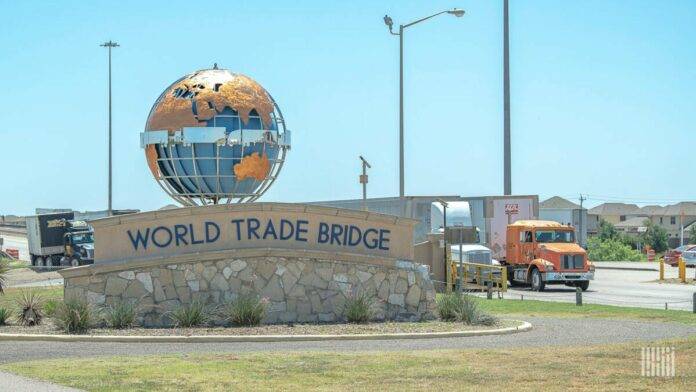Chart of the Week: Outbound Tender Reject Index and Outbound Tender Volume Index – Laredo
The Outbound Tender Reject Index (OTRI) and Outbound Tender Volume Index (OTVI) are critical indicators of the truckload capacity landscape in Laredo, Texas, which serves as the largest border crossing market in the United States. Recent data reveals that shippers in this region are experiencing the highest rejection rates for truckload capacity requests since the onset of the pandemic.
The OTRI measures the percentage of truckload capacity requests that carriers decline. A rise in rejection rates is generally viewed as a signal of a tightening market, indicative of limited available capacity. In Laredo, rejection rates for outbound loads averaged approximately 3.8% from October through mid-December. However, just before Christmas, these rates surged past 6% and have unexpectedly remained at elevated levels.
Demand Alone May Not Explain the Tightening
Despite demand running approximately 10% higher year-over-year since October, the spike in rejection rates around the holiday season indicates that demand alone cannot fully account for the tightening of the market. One significant factor contributing to this situation is the uncertainty surrounding U.S. trade policies. Over the past month, the administration has threatened, enacted, and then paused tariffs on Mexico, the country’s largest trading partner by value. This unpredictability has led shippers to expedite the movement of goods to avoid potential cost increases, thereby sustaining a growth in cross-border freight demand. Yet, the persistent rise in rejection rates suggests that additional complexities are influencing the market.
Laredo’s Unique Market Dynamics
From an outbound freight perspective, Laredo is a relatively small market, ranking 48th out of 135 U.S. freight markets, and accounting for just 0.7% of total outbound freight volume. Its geographic location—approximately a day’s drive from Dallas and just over half a day from Houston—adds to its remoteness. Notably, Laredo handles a higher volume of freight moving out of the region compared to that originating within it, a trend that has intensified over the last year. This outbound-focused freight pattern can strain carrier networks, resulting in inefficiencies within the supply chain.
Pricing Matters
Pricing dynamics play a crucial role in the Laredo market. In larger outbound markets, such as Los Angeles, shippers typically account for the additional costs associated with repositioning empty trucks, often referred to as "deadheading." However, in Laredo, the cost to serve has increased even as broader freight rates have declined. Carriers have encountered challenges in passing along the expenses associated with repositioning, which diminishes their incentive to prioritize freight bound for Laredo.
Contract rates for key lanes, such as Laredo to Dallas, have surged by 13% year-over-year, and spot rates have increased by 8%. Yet, these price escalations have not been sufficient to maintain an adequate number of carriers in the market to avert rising rejection rates. A significant contributing factor is that carrier focus remains heavily directed toward California, where there has been sustained elevated demand driven by imports.
California’s Freight Boom is Drawing Capacity Away
The Los Angeles market appears to be absorbing a considerable portion of available truckload capacity. Geopolitical factors and tariffs have propelled Asian imports to near-pandemic levels, amplifying demand in this critical freight hub. Unlike Laredo, Los Angeles boasts a massive freight market with longer haul distances, rendering it more appealing to carriers. Currently, freight volumes in the Los Angeles area are up 7-8% year-over-year, while rejection rates remain below 3%, indicating a more relaxed capacity environment. The average haul lengths exceed 900 miles, and with rates having risen since last summer, carriers are increasingly prioritizing California over smaller, less lucrative markets like Laredo.
Laredo is not the only market witnessing vulnerability in capacity; the Chicago market has also experienced rising rejection rates, which have sustained levels above 7%. The overarching narrative suggests that a significant amount of capacity has either left or is in the process of leaving the domestic truckload market, contributing to the uptick in market-level rejection rates. As carrier networks become more challenging to manage, the reduced buffer against demand fluctuations exacerbates the situation.
About the Chart of the Week
The FreightWaves Chart of the Week is a carefully selected visualization from SONAR that elucidates the current state of freight markets. Each week, a Market Expert curates a chart from thousands of options available on SONAR to provide insights into real-time freight market dynamics. Following its initial posting on the front page, the Chart of the Week is archived on FreightWaves.com for future reference.
SONAR aggregates data from a multitude of sources, presenting this information through charts and maps, along with expert commentary on industry trends. The FreightWaves data science and product teams are committed to releasing new datasets weekly and enhancing the client experience.
For those interested in exploring SONAR further, a demo request can be made here.




